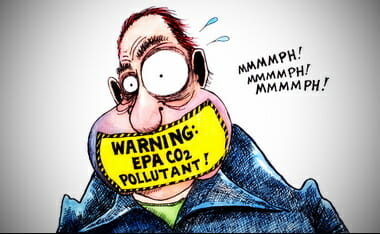Why is McCulloch v. Maryland considered such an essential case? Prof. David Schwartz of the University of Wisconsin’s Law School explains how McCulloch v. Maryland helped identify fundamental principles of federalism.
Federalism


Progressivism vs. Declaration (4th of July Primer)
(School is in!) Mark Levin shares his study of the U.S. Constitution and it’s Founding. The American Founding. Levin discusses the miracle of the death of the two men key to the Declaration’s appearance (Jefferson and Adams) on the Fourth of July. He then treads into progressive waters and the current dislike of our American Founding as compared to history. He reads from Woodrow Wilson (our first Ph.D. President) and his disdain for the Founding document and Principles. Then a reading from — really a counter point — Calvin Coolidge to cement the idea that these are eternal principles. Levin wonders aloud how Leftists can even celebrate the 4th in good conscience.
About the Declaration there is a finality that is exceedingly restful. It is often asserted that the world has made a great deal of progress since 1776, that we have had new thoughts and new experiences which have given us a great advance over the people of that day, and that we may therefore very well discard their conclusions for something more modern. But that reasoning can not be applied to this great charter. If all men are created equal, that is final. If they are endowed with inalienable rights, that is final. If governments derive their just powers from the consent of the governed, that is final. No advance, no progress can be made beyond these propositions. If anyone wishes to deny their truth or their soundness, the only direction in which he can proceed historically is not forward, but backward toward the time when there was no equality, no rights of the individual, no rule of the people. Those who wish to proceed in that direction can not lay claim to progress. They are reactionary. Their ideas are not more modern, but more ancient, than those of the Revolutionary fathers. — Calvin Coolidge (POWERLINE)
BTW, if one does not know the history of the fourth in regard to Jefferson and Adams, or the eternal principles BEHIND the Declaration, here are some decent videos:

U N I T E D States – Mark Davis
Mark Davis filled in for Dennis Prager, and when he does, the Constitutional guidelines are typically discussed. (See my previous upload of Mark “Roe v Wade and States Rights Explained“) In this segment[s], he takes a call from a challenger and opines more on his previous statements.

California vs. America
Below are two positions taken by a left leaning columnist and a right leaning columnist that essentially say the same thing. SOMETHING, mind you, Dennis tapped into some time ago in his article entitled, “AMERICA’S SECOND CIVIL WAR.” Here are the other two articles mentioned in these audios:
- Tim Arango of the New York Times: “In Clash Between California and Trump, It’s One America Versus Another“
- Michael Walsh* at American Greatness: “Democrats Fire on Fort Sumter“
Before beginning I just wish to say that California is working against the clear Constitutional mandates that the Federal government controls and protects its borders… and the Trump administration is working against the Constitution in its trying to fight against California’s legalization of marijuana. NOTE! If you are for the state of California choosing to legalize pot, but against the state defining marriage as between one-man and one-woman… you are a confused individual who makes choices on emotion and not Constitutional foresight/understanding. When Walsh and Prager discuss “arresting California lawmakers,” in my minds eye the legal standing ta do this is Article IV, Section 4 of the Constitution — which reads:
- “The United States shall guarantee to every state in this union a republican form of government…“
I have been warning about this for years in regard to The Golden State… California is setting itself and our country up for a world of hurt.
NEW YORK TIMES:
AMERICAN GREATNESS:
* Michael Walsh is a journalist, author, and screenwriter. He was for 16 years the music critic of Time Magazine. His works include the novels, “As Time Goes By,” “And All the Saints” (winner, 2004 American Book Award for fiction) and the “Devlin” series of thrillers; as well as the recent nonfiction bestseller, “The Devil’s Pleasure Palace.” A sequel, “The Fiery Angel,” is scheduled to appear in 2018.

Kimberley Strassel Discusses Trump’s “Federalist Revival”
KIMBERLEY STRASSEL discusses the fight for Federalism and how Scott Pruitt will help in this endeavor:
Donald Trump had barely finished announcing his pick to lead the Environmental Protection Agency before the left started listing its million reasons why Oklahoma Attorney General Scott Pruitt was the worst nomination in the history of the planet: He’s an untrained anti-environmentalist. He’s a polluter. He’s a fossil-fuel fanatic, a lobbyist-lover, a climate crazy.
Mr. Pruitt is not any of those things. Here’s what he in fact is, and the real reason the left is frustrated: He’s a constitutional scholar, a federalist (and a lawyer). And for those reasons he is a sublime choice to knock down the biggest conceit of the Obama era—arrogant, overweening (and illegal) Washington rule.
We’ve lived so many years under the Obama reign that many Americans forget we are a federal republic, composed of 50 states. There isn’t a major statute on the books that doesn’t recognize this reality and acknowledge that the states are partners with—and often superior to—the federal government. That is absolutely the case with major environmental statues, from the Clean Air Act to the Clean Water Act to the Safe Drinking Water Act.
Congress specifically understood in crafting each of these laws that one-size-fits all solutions were detrimental to the environment. Federal bodies like the Environmental Protection Agency traditionally and properly existed to set minimum standards, provide technical support, and engage in occasional enforcement. States, with their unique knowledge of local problems, economies and concerns, were free to innovate their own solutions.
But President Obama never held much with laws, because he failed at making them. After his first two years in office, he never could convince the Congress to pass another signature initiative. His response—and the enduring theme of his presidency—was therefore to ignore Congress and statutes, go around the partnership framework, and give his agencies authority to dictate policy from Washington. The states were demoted from partners to indentured servants. So too were any rival federal agencies that got in the EPA’s way. Example: The EPA’s pre-emptive veto of Alaska’s proposed Pebble Mine, in which it usurped Army Corps of Engineers authority.
One revealing illustration from EPA world. Under the Clean Air Act, states are allowed to craft their own implementation plans. If the EPA disapproves of a state plan, it is empowered to impose a federal one—one of the most aggressive actions the agency can take against a state, since it is the equivalent of a seizure of authority. In the entirety of the presidencies of George H.W. Bush,Bill Clinton and George W. Bush, the EPA imposed five federal implementation plans on states. By last count, the Obama administration has imposed at least 56.
Much of Mr. Pruitt’s tenure as Oklahoma’s AG was about trying to stuff federal agencies back into their legal boxes. Most of the press either never understood this, or never wanted to. When the media wrote about state lawsuits against ObamaCare or the Clean Power Plan or the Water of the United States rule, the suggestion usually was that this litigation was ideologically motivated, and a naked attempt to do what a Republican Congress could not—tank the president’s agenda.
The basis of nearly every one of these lawsuits was in fact violations of states’ constitutional and statutory rights—and it is why so many of the cases were successful. It was all a valiant attempt to force the federal government to follow the law. And it has been a singular Pruitt pursuit.
[….]
It doesn’t need a climate warrior, as Congress has never passed a climate law, and so the EPA has no mandate to meddle there. What it needs is a lawyer, one with the knowledge of how to cut the agency back to its proper role—restoring not just an appropriate legal partnership with the states, but also with other federal bodies. One who reminds agency staff that the EPA was not created to oppose growth and development.
If Mr. Pruitt does this successfully, and on the way crushes the current president’s legacy, Mr. Obama will have only himself to blame. His abuse of federal power helped elect a new generation of state attorneys general and Washington Republicans passionately devoted to a states’ rights agenda. They’ll be advising Mr. Trump not just on environmental policy, but on health care, labor policy, entitlement reform. Say hello to the federalist revival.

Awesome! Ranchers & Cowboys Stood Off Federal Agents
“Power kills; absolute power kills absolutely…. The more power a government has, the more it can act arbitrarily according to the whims and desires of the elite…”
~ R.J. Rummel — from the classic book, Death by Government
Right or wrong, this militarized action is getting worrisome. Even how the Bureau of Land and Management (BLM) retreated, as if this group of citizens were a military force poised to attack. All they wanted was to retrieve Cliven Bundy’s cattle. The government is making wise choices here… to back off. But this is better handled in court. Remember, Ruby Ridge led to (in part) the Oklahoma City Bombing:
Unfortunately, when the Attorney General, as the highest law enforcement official in the country, does not vigorously pursue justice in cases where government clearly employed improper force, a cancerous suspicion metastasizes in the body of society with potentially devastating effects. Not least of all, it encourages dangerous extremists like those in the Oklahoma City bombing.
Dean Koontz ~ horror/fiction author ~ in the foreword of Ambush at Ruby Ridge, by Alan Bock.
In an epic standoff that, supporters of Nevada cattle rancher Cliven Bundy advanced on a position held by BLM agents despite threats that they would be shot at, eventually forcing BLM feds to release 100 cattle that had been stolen from Bundy as part of a land grab dispute that threatened to escalate into a Waco-style confrontation.
Red and Blue States Eyeballing Federalism Anew
A must read article from the City-Journal:
In February 2013, Utah governor Gary Herbert canceled plans to establish a state-run exchange for individual health insurance, bringing to 34 the number of states opting out of that essential piece of the Affordable Care Act. Meanwhile, another part of the law, an expansion of Medicaid rolls, is being defied by more than 20 states. Having survived congressional logrolling, Tea Party rallies, a presidential election, and a Supreme Court case, Obamacare may yet be sunk by a resurgent force that many had thought dead: federalism.
The new federalist fervor is coming from both sides of the aisle. Among the governors refusing to create state health-insurance exchanges are two Democrats (in Missouri and Montana), while the Democratic governor of President Obama’s home state, Illinois, is willing only to “partner” with the federal government in setting up an exchange. Nor is the resistance limited to Obamacare. Last November, California’s Democratic governor, Jerry Brown, warned “federal gendarmes” to stop interfering with his state’s medical-marijuana law—echoing former Massachusetts representative Barney Frank, who had championed medical marijuana as a states’ rights issue for years. Such deep-blue states as New York and Massachusetts have tried (unsuccessfully) to block the Secure Communities Act, which requires every arrested person’s fingerprints to be run through federal immigration databases. The Democratic governor of locavore Vermont is locked in a battle with the feds over who gets to determine the future of the Vermont Yankee Nuclear Power Plant: the state legislature or the presidential appointees on the Nuclear Regulatory Commission. In March 2012, Yale law professor Heather Gerken took to the pages of Democracy to urge her fellow progressives to embrace federalism because state and local governments were more effective “sites of empowerment for racial minorities and dissenters” than the federal government.
Conservatives may still be the most vocal advocates of greater state autonomy, but federalism is far from a uniquely conservative phenomenon. Indeed, the revival of states’ rights is a movement that has the potential to unite Left and Right while fundamentally changing the balance of power in America.
Political scientists divide American federalism—broadly speaking, the system that divides sovereignty between the federal government and the states—into three eras: dual, cooperative, and coercive. Dual federalism, which lasted from 1789 until the New Deal, reflected the Founders’ original understanding of the state and federal governments as joint sovereigns, each supreme within its own sphere. Article I of the Constitution grants Congress relatively few powers, relating to defense, tariffs, and the like. The Tenth Amendment, added in 1791, clarifies that the states and the people retain all powers not delegated to the central government. Even before the Tenth Amendment, however, James Madison observed in Federalist 45 that the Constitution gave states nearly complete power to pass and enforce laws touching on “the lives, liberties, and properties of the people, and the internal order, improvement, and prosperity of the State.” Realizing that individual liberty is at risk whenever political power becomes concentrated in one level or one branch of government, the Constitution’s framers considered federalism, together with the separation of powers, a far more important safeguard of freedom than the Bill of Rights.
During the era of dual federalism, the national government focused on its constitutional duties while the state and local governments tended to the safety and welfare of their residents. The debates of the time would seem quaint today, such as the controversy that raged over Congress’s authority to subsidize infrastructure projects; as president, Madison vetoed a bill providing for roads, canals, and other “internal improvements” as beyond the powers of the federal government. At the end of the nineteenth century, the British historian Lord Acton credited America’s division of power with producing “a community more powerful, more prosperous, more intelligent, and more free than any other the world has seen.”
Franklin Roosevelt’s New Deal put an end to dual federalism. At first, the Supreme Court killed off a number of the president’s new programs, but after FDR threatened to install six additional pro-administration justices, it began to change course. In the 1941 case United States v. Darby, which upheld the federal takeover of wage and hour laws, the Court brushed aside the Tenth Amendment as a mere “truism” that didn’t limit the scope of Congress’s powers. Thus was born the era of cooperative federalism, characterized by “a constantly increasing concentration of power at Washington in the stimulation and supervision of local policies,” as FDR advisor Edward Corwin put it. Notwithstanding the federal encroachment on their turf, states often welcomed the new federal programs because they were accompanied by unprecedented grants. Those grants were subject to relatively few conditions; instead, the federal government treated the states as partners in implementing national policy and gave state officials considerable flexibility in carrying out their roles.
The cooperative model began to break down in the 1960s, as Congress attached ever more specific and intrusive conditions to federal aid. The Highway Beautification Act of 1965, for example, told states to follow federal rules for regulating billboards or lose 10 percent of their highway funding. By the 1970s, such conditional grants, combined with unfunded mandates—marching orders that the federal government issues but doesn’t pay for—created the model that persists to this day: coercive federalism.
